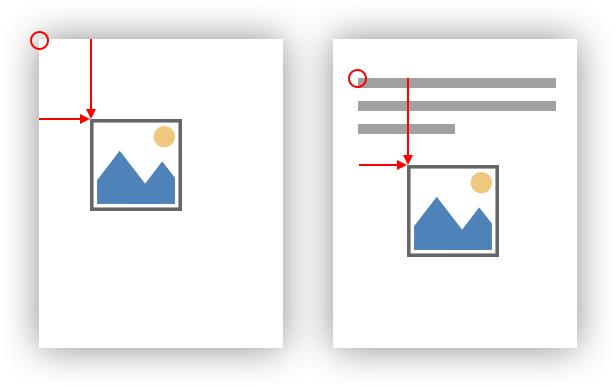Different Ways to Insert Images
Images can be added to a document from various sources: Physical files, streams or System.Drawing.Images. This article explains how to create images and to add them to a document.

In order to insert an image into a document, an Image object must be created. In the first example, an image is created from a physical file:
TXTextControl.Image image = new TXTextControl.Image("image.png", 4);
textControl1.Images.Add(image, -1);According to the documentation, it is required to provide the import filter index in the constructor of the Image class. The index can be retrieved using the Import
Another way to create an Image object is to provide a System.Drawing.Image in the constructor. In this case, you can create any bitmap image and load it into the Text Control:
System.Drawing.Image sdImage = System.Drawing.Image.FromFile("image.png");
TXTextControl.Image image = new TXTextControl.Image(sdImage);
textControl1.Images.Add(image, -1);Images from a Stream
In a third implementation, an image can be created from a stream. The MemoryStream must be publicly visible as Text Control is accessing the stream when the image is actually added to the document:
byte[] bytes = System.IO.File.ReadAllBytes("image.png");
MemoryStream ms = new MemoryStream(
bytes, 0, bytes.Length, writable: false, publiclyVisible: true);
TXTextControl.Image image = new TXTextControl.Image(ms);
textControl1.Images.Add(image, -1);All of the above samples insert the image at a text position and the image is handled inline like a character. The following insertion modes are available:
- Inline with text
- Anchored to a paragraph
- Fixed on a page
Combine Insertion Modes
The following Insertion
| Member | Description |
|---|---|
| AsCharacter | The image is inserted in the text as a single character. |
| DisplaceCompleteLines | The image is inserted at a certain geometrical location. The text stops at the top and continues at the bottom of the image. |
| DisplaceText | The image is inserted at a certain geometrical location. The text flows around the image and empty areas at the left and right side are filled. |
| AboveTheText | The image is inserted at a certain geometrical location above the text. This means that the image overwrites the text. |
| BelowTheText | The image is inserted at a certain geometrical location below the text. This means that the text overwrites the image. |
| MoveWithText | The image is connected with a paragraph and moved with the text. |
| FixedOnPage | The image is fixed positioned on a page. |
The values of the ImageInsertionMode enumeration can be combined. The following combinations are possible:
- DisplaceCompleteLines | MoveWithText
- DisplaceCompleteLines | FixedOnPage
- DisplaceText | MoveWithText
- DisplaceText | FixedOnPage
- AboveTheText | MoveWithText
- AboveTheText | FixedOnPage
- BelowTheText | MoveWithText
- BelowTheText | FixedOnPage
- AsCharacter
Anchored to Paragraphs
For example, the following code inserts an image that is anchored to the paragraph at the current input position with a location offset of 500 twips in both directions:
TXTextControl.Image image = new TXTextControl.Image("image.png", 4);
textControl1.Images.Add(image, new Point(500,500), -1,
TXTextControl.ImageInsertionMode.MoveWithText |
TXTextControl.ImageInsertionMode.DisplaceText);The location is given in twips at which the image is to be inserted. This is a location relative to the top left corner either of a page or a paragraph.

Also See
This post references the following in the documentation:
- TXText
Control. Image Class - TXText
Control. Image Collection. Add Method - TXText
Control. Image Collection Class
ASP.NET
Integrate document processing into your applications to create documents such as PDFs and MS Word documents, including client-side document editing, viewing, and electronic signatures.
- Angular
- Blazor
- React
- JavaScript
- ASP.NET MVC, ASP.NET Core, and WebForms
Related Posts
TX Text Control 34.0 SP1 is Now Available: What's New in the Latest Version
TX Text Control 34.0 Service Pack 1 is now available, offering important updates and bug fixes for all platforms. If you use TX Text Control in your document processing applications, this service…
Introducing TX Text Control 34.0: Your Next Leap in Document Processing.
We are happy to announce the release of TX Text Control 34.0. This version is packed with new features and enhancements that will elevate your document processing experience. This version…
Sneak Peek: TX Text Control 34.0 Coming November 2025
We are excited to announce the upcoming release of TX Text Control 34.0, scheduled for November 2025. This update brings a host of new features and improvements to enhance your document processing…
TX Text Control 33.0 SP3 is Now Available: What's New in the Latest Version
TX Text Control 33.0 Service Pack 3 is now available, offering important updates and bug fixes for all platforms. If you use TX Text Control in your document processing applications, this service…
TX Text Control 33.0 SP2 is Now Available: What's New in the Latest Version
TX Text Control 33.0 Service Pack 2 is now available, offering important updates and bug fixes for all platforms. If you use TX Text Control in your document processing applications, this service…






